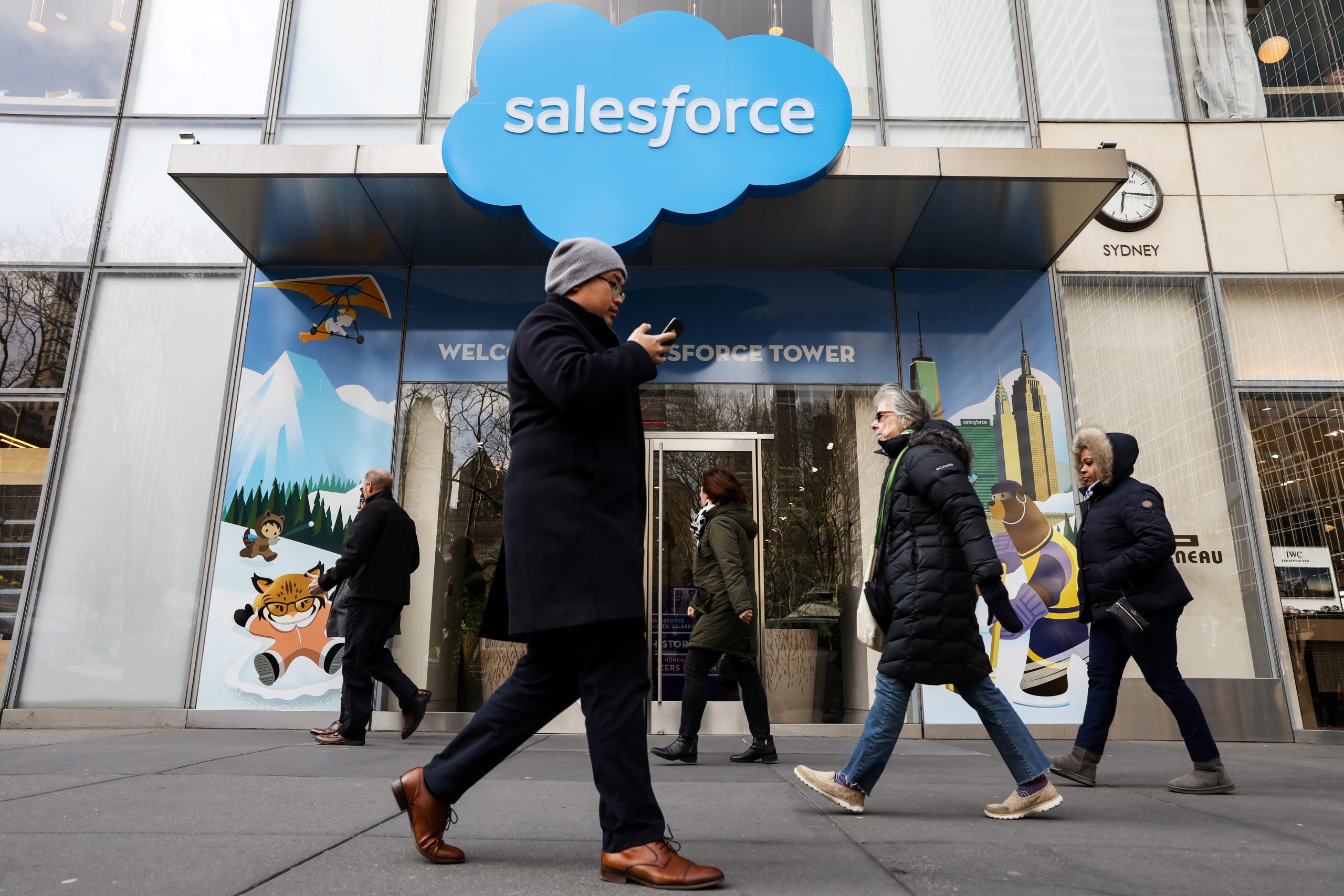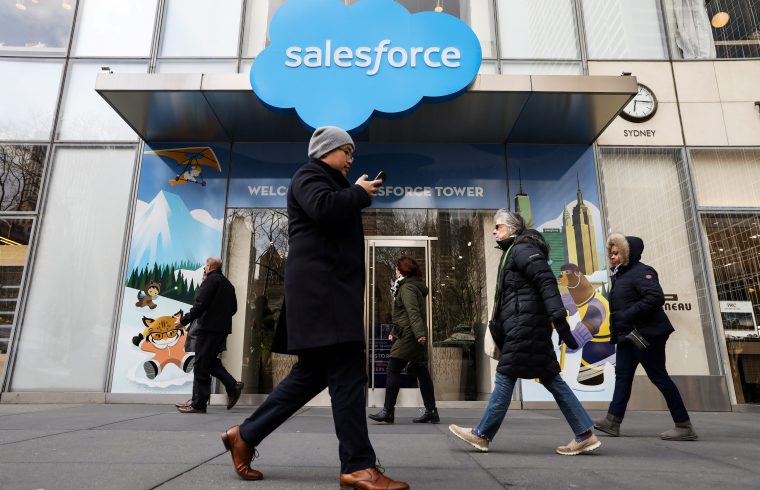
People pass by the Salesforce Tower and Salesforce.com offices in New York City, March 7, 2019.
Brendan McDermid | Reuters
What seemed like a few decades ago, I mean in February, people used to occasionally ask “How’s business?” Despite usually responding, “Fine, thanks,” I would often think of the inquiry as two-part. One, and probably most important, was about our investment performance, but the other concerned our operations, particularly new business.
One of my Covid-induced fears is that we don’t know how to attract new business in the remote age. We have never landed a good-sized account without one in-person encounter, but that needs to change. I crave a different “demand pull” model where potential shoppers need to come to us and realize I wouldn’t like the one stuck in my mind – a grocery store. Once we have accommodated the prospects whom we met with pre-Covid, what is our strategy? At least, we operate under an ongoing fee model, thanks to clever investment industry pioneers centuries ago.
Face-to-face interactions are a mainstay of many industries in which there is often a costly and lengthy selling process for each order. Would those firms with the highest selling burden, whether pharmaceuticals, computer hardware, medical equipment, or automobiles, be penalized by the stock market, which recognizes the intense difficulty social distancing and travel restrictions places on their businesses? Have some been successful in depersonalizing their marketing efforts through new online and social media practices?
Historically, buying a new model of any expensive type of industrial or transportation vehicle (Tesla being the exception with only online sales), as well as, real estate, would also require at least one face-to-face encounter. If current constrained selling is depressing some stocks, that pain should persist until we either have better control over the virus or have adopted new tools that replace the in-person experience. Investors might, therefore, be smart to avoid such exposed companies.
Can we tell which corporate sales department rely most on face-to-face meetings? The most obvious proxy would be sales, general and administrative expenses, or SG&A. The table below, which ranks industry sectors by SG&A as a percent of sales, shows little correlation between higher SG&A and price action this year. Among the worst-performing groups have been energy and utilities, which dedicate relatively little to selling expenses. Technology, which ranks second to heath care in average spend, is by far, the best-performing group of 2020, up almost 15% in the first half.
To put it simply, we know that many tech firms can provide the service and products seamlessly as long as the wifi is working, whether in the office or at home. On the opposite end, health care has been overwhelmed by Covid-19 and all elective surgeries, procedures and doctor visits were cancelled or held virtually for many months, decimating revenues.
General and administrative expenses
| Sector | # of Cos SG&A > 40% of Revs | Avg SG&A % of Revs | LTM EBIT % of Revs | Performance 12/31/19 – 6/30/20 | Performance 3/23/20 – 6/30/20 |
|---|---|---|---|---|---|
| Health Care | 22 | 34.00% | 19.10% | -1.70% | 34.10% |
| Information Technology | 19 | 33.00% | 21.30% | 14.20% | 48.50% |
| Communication Services | 4 | 26.00% | 17.30% | -1.00% | 30.60% |
| Consumer Discretionary | 10 | 24.30% | 10.80% | 6.60% | 47.30% |
| Consumer Staples | 2 | 21.90% | 17.90% | -7.10% | 20.00% |
| Financials | 2 | 18.80% | 33.40% | -24.60% | 31.30% |
| Industrials | 0 | 16.40% | 15.90% | -15.50% | 41.00% |
| Utilities | 0 | 12.70% | 21.80% | -12.60% | 26.00% |
| Materials | 0 | 12.70% | 13.20% | -8.00% | 46.80% |
| Real Estate | 0 | 5.90% | 31.20% | -9.50% | 36.10% |
| Energy | 0 | 5.20% | 7.20% | -37.00% | 58.80% |
In fact, SG&A is not even a good indicator of face-to-face sales efforts, because of the broad inclusion criteria in that category. Since the overall SG&A bucket includes everything from legal, rent, advertising, and management salaries, teasing out the sales force that meets with potential customers is extremely difficult.
Some companies break out their selling and marketing expense from SG&A, so we examined those companies with heavy S&M spending. The table below illustrates that 17 of the top 20 on the list are technology participants, such as Salesforce.com, Autodesk, and Citrix, all software firms with enormous gross margins. That cushion allows them to spend heavily on the sales effort, whether in-person or virtual, and still maintain hefty profit margins.
Most of these stocks have been strong outperformers in 2020. In contrast, Expedia, the company that topped the list, saw its stock collapse this year, not because of its high marketing spend, but because it sits squarely at the center of the withered travel industry.
Selling and marketing
| Ticker | Sector | LTM S&M % of LTM Rev | LTM EBIT % of Revs | Performance 12/31/19 – 6/30/20 | Performance 3/23/20 – 6/30/20 |
|---|---|---|---|---|---|
| EXPE | Consumer Discretionary | 49.80% | 5.90% | -23.70% | 61.70% |
| CRM | Information Technology | 47.30% | 0.80% | 15.20% | 33.30% |
| NOW | Information Technology | 43.40% | 2.90% | 43.50% | 58.60% |
| FTNT | Information Technology | 43.00% | 16.50% | 28.60% | 59.80% |
| ADSK | Information Technology | 39.30% | 13.10% | 30.40% | 65.90% |
| CTXS | Information Technology | 37.60% | 20.80% | 34.00% | 21.90% |
| FFIV | Information Technology | 35.70% | 18.70% | -0.10% | 41.40% |
| NLOK | Information Technology | 29.50% | 20.90% | 25.70% | 20.40% |
| NTAP | Information Technology | 29.30% | 17.20% | -27.20% | 26.90% |
| INTU | Information Technology | 29.20% | 22.50% | 13.50% | 52.40% |
| EBAY | Consumer Discretionary | 29.20% | 22.20% | 46.10% | 99.70% |
| ADBE | Information Technology | 28.10% | 31.20% | 32.00% | 41.70% |
| TWTR | Communication Services | 26.70% | 7.60% | -7.10% | 20.70% |
| PAYC | Information Technology | 25.00% | 32.40% | 17.00% | 73.10% |
| JNPR | Information Technology | 21.40% | 10.50% | -5.60% | 33.40% |
| ORCL | Information Technology | 20.70% | 36.40% | 5.20% | 25.60% |
| CDNS | Information Technology | 20.60% | 21.50% | 38.40% | 71.80% |
| CSCO | Information Technology | 18.70% | 28.70% | -1.30% | 35.80% |
| SNPS | Information Technology | 18.20% | 16.20% | 40.10% | 79.80% |
| AKAM | Information Technology | 17.70% | 20.00% | 24.00% | 25.20% |
Rather than simply consider corporate selling percentages, which offer very limited insight into how the funds are used, investors should apply common sense to the exercise. The factors that clearly have a negative effect on revenues, profits, and expected returns, in a remote world are:
- An intrinsic, legacy sales force, built on face to face practices.
- Very high-ticket prices for the company’s complex products.
- Management resistance to shift toward online and virtual sales methods.
Drug companies have sold, for decades, by visiting doctors’ offices and hosting events or speaker series about innovative, newly approved therapies. They now are aggressively promoting new therapies online, directed at specific patient populations.
The market has not punished stocks like Booking Holdings, Coca Cola, Merck, and Caterpillar because they have high sales and marketing expenses. Companies like PayPal, Microsoft, Akamai and Activision are also huge spenders in that category, and their stocks also have soared this year. Investors have sold and bought stocks based on perceptions of how the pandemic will impact their business.
However, all of us who have relied on in-person selling need to creatively devise outreach programs that supplement or replace our traditional methods in order to thrive. Investors should listen carefully to how managements describe their efforts to reimagine their selling process. I’ll be listening too, hopefully for some good ideas.
Karen Firestone is chairman, CEO, and co-founder of Aureus Asset Management, an investment firm dedicated to providing contemporary asset management to families, individuals and institutions.







